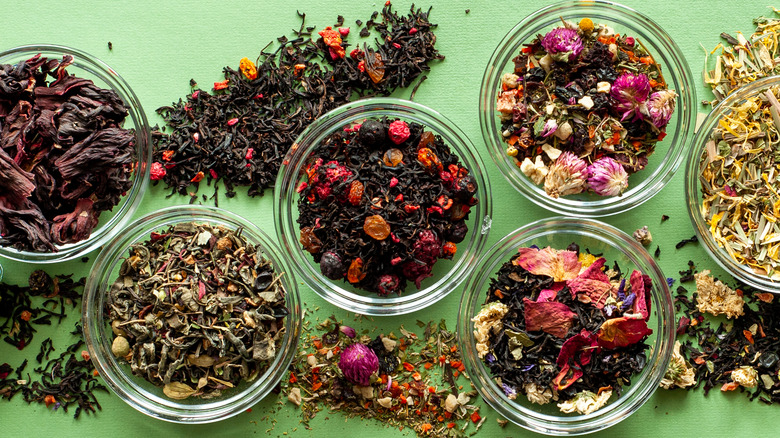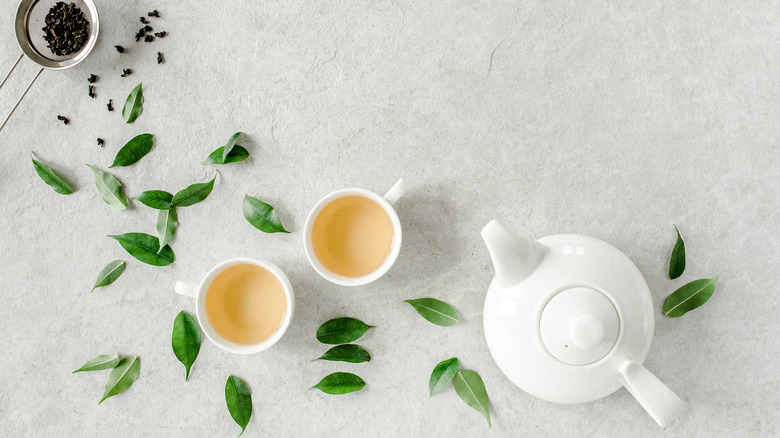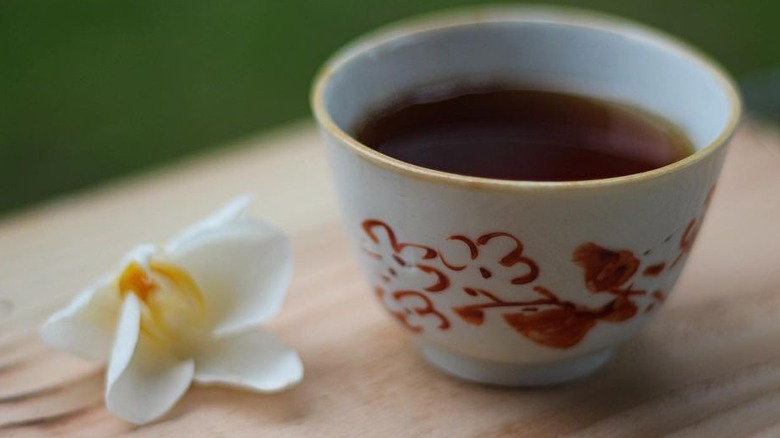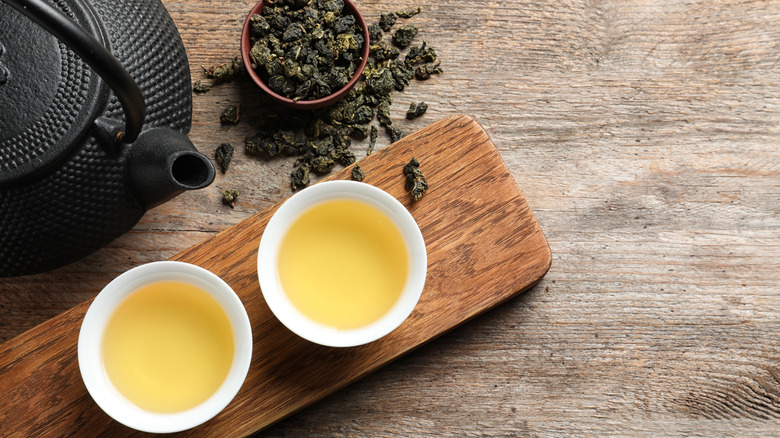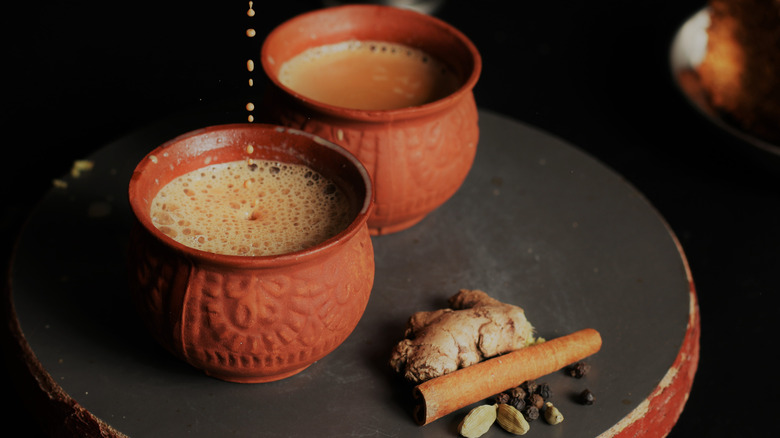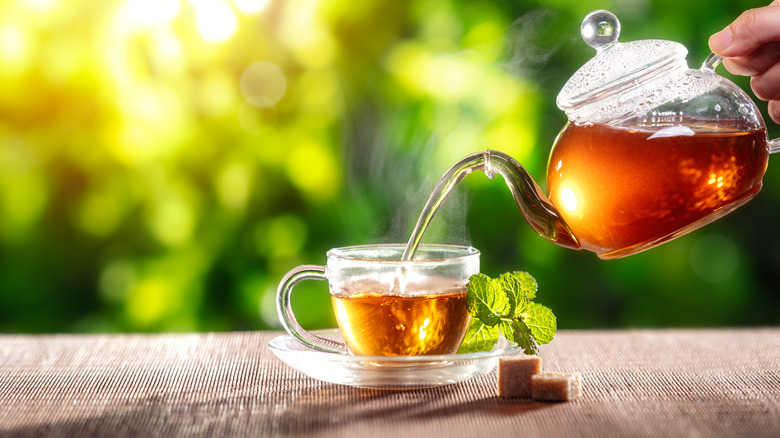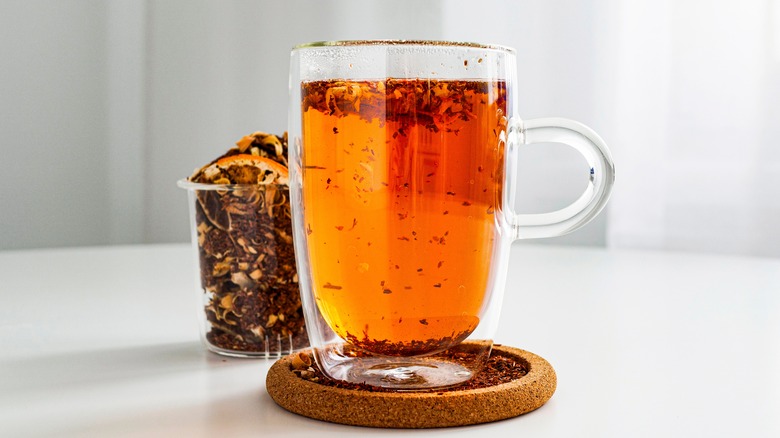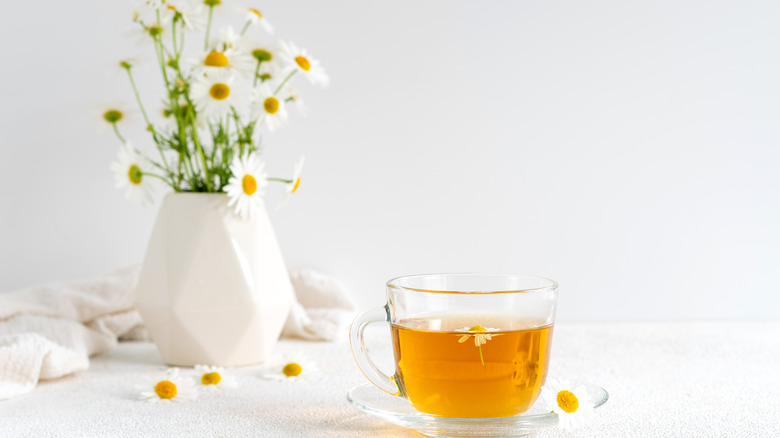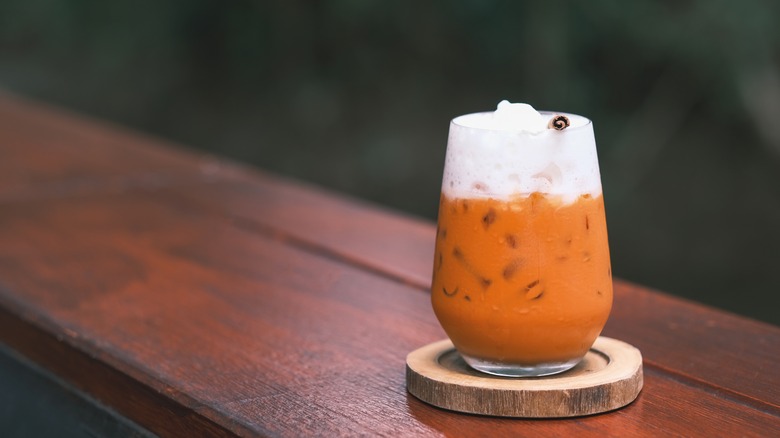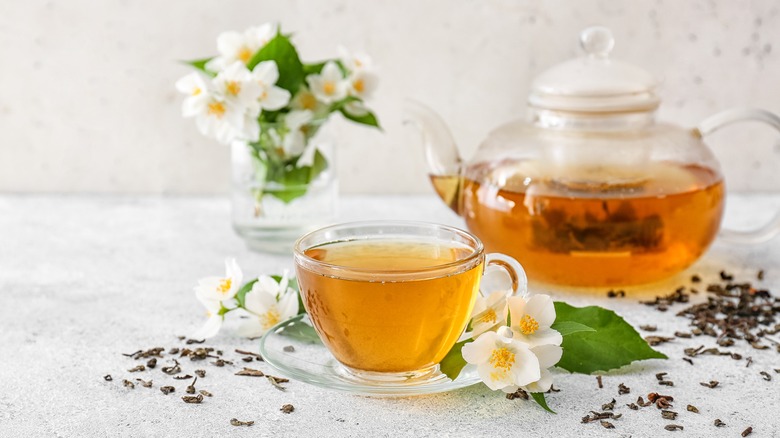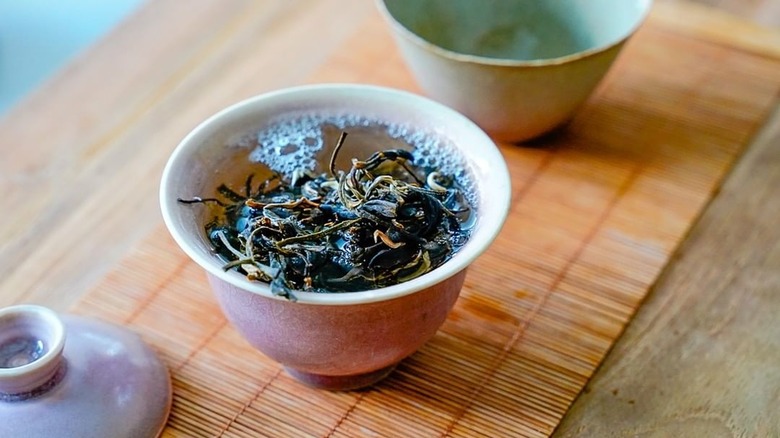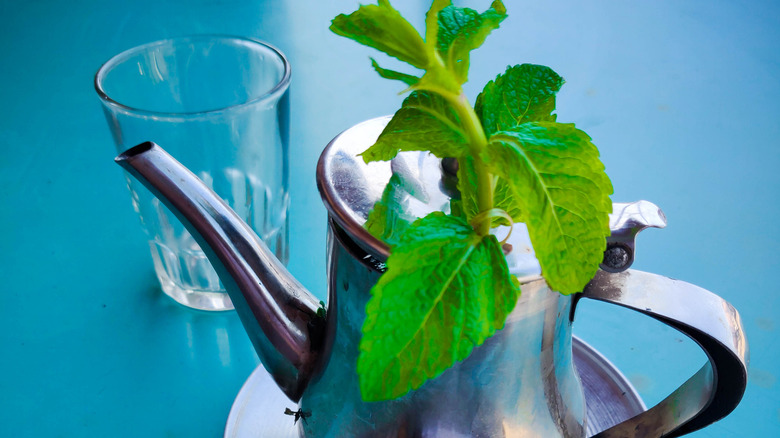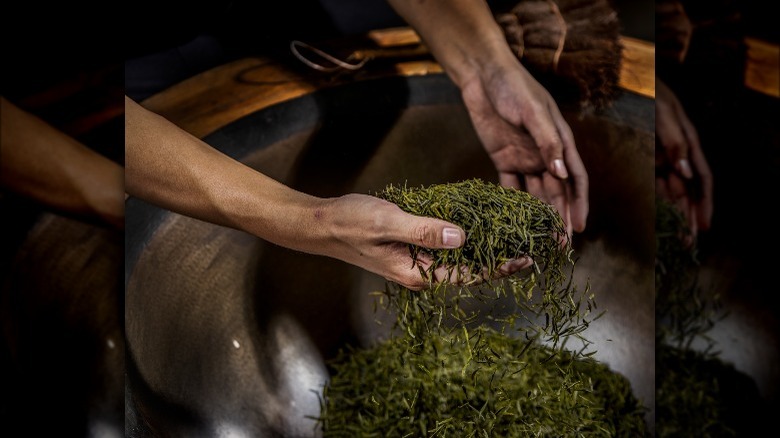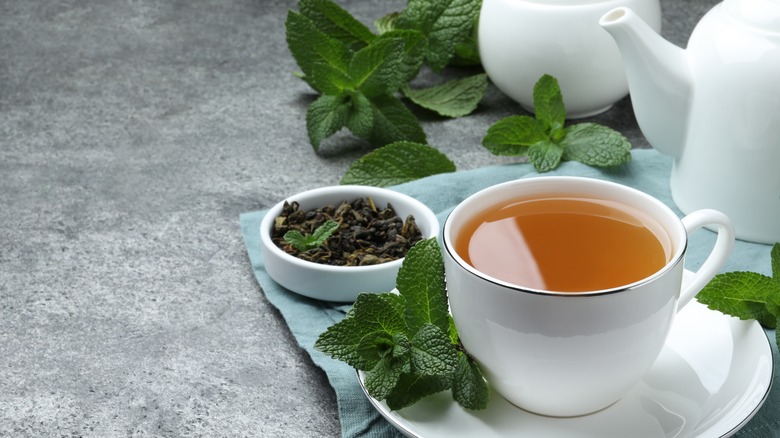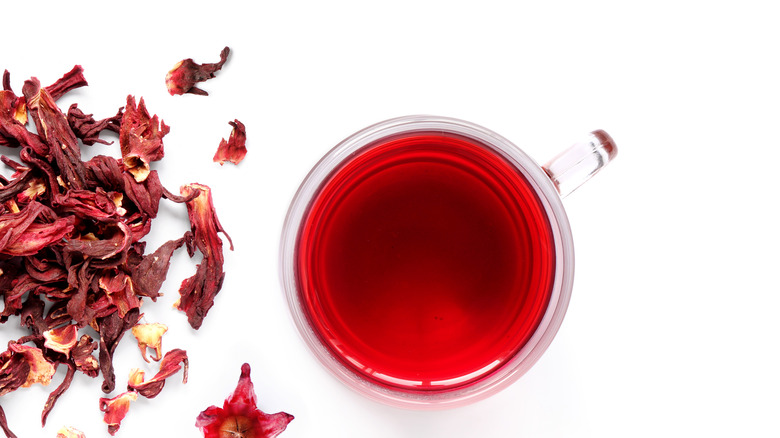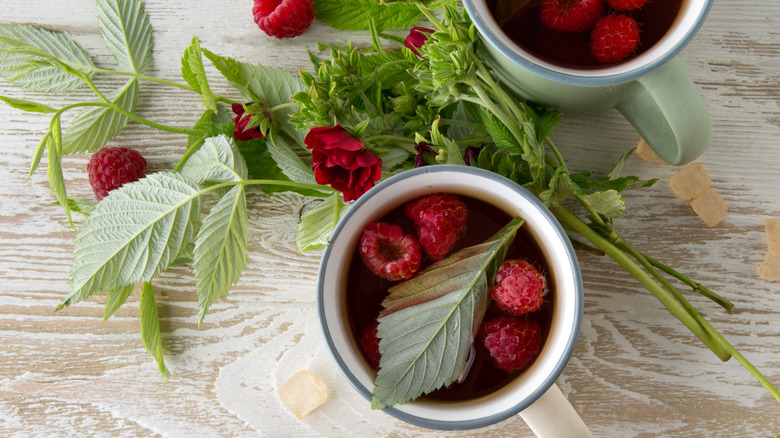15 Best Tea Flavors Ranked
Who doesn't love tea? There's frankly nothing more comforting than wrapping your hands around a steaming cup and feeling the warmth seep through you as you take the first sip. It's not just us; the entire world is obsessed with tea. As per Statista, over 13 billion pounds were consumed in 2020.
Tea is more than just a comforting beverage, however. As Penn Medicine reports, it can potentially be effective in boosting your immune system, fighting inflammation, and protecting against heart disease and cancer. And that's just the tip of the iceberg. Since it's loaded with tannins, antioxidants that can protect your skin from environmental damage, tea is a popular skincare ingredient as well (via Molecules).
Black tea is a classic choice. But if you are in the mood for something more exotic, this is the guide for you. We have ranked the 15 best tea flavors from around the world so that you can be transported to a new setting with every sip.
1. Green Tea
You simply can't go wrong with green tea, aka the OG of teas — or you might even call it the king of all teas. Most tea comes from the Camellia sinensis species of evergreen plants. Green tea is no exception, however, it offers a unique taste. Take a sip, and you'll experience a range of flavors — warm, fruity, and earthy. Combine it with a splash of fresh lemon juice for an enhanced citrusy flavor.
As BRUU notes, celebrities like Christina Aguilera, Lady Gaga, Drew Barrymore, and Barack Obama, all love the green brew, which is believed to have weight loss properties. Besides these potential characteristics, green tea is packed with antioxidants. It's also a popular ingredient added to skincare products. Furthermore, according to Healthline, regularly drinking green tea may improve your metabolism and reduce the risk of developing Alzheimer's disease.
But enough with the science. Let's talk about how to consume this green elixir. Green tea works exceptionally well after heavy meals as it can help boost digestion. If you want to give it a twist, drink it sweetened with sugar or honey. And if you really want to shake things up, you can whip up a delicious green tea ice cream.
2. White Tea
Best served unsweetened, white tea is a delicious variety that has a floral, citrusy flavor profile. Best of all, it's free from the grassy taste often experienced with green tea. White tea is derived from the young buds and leaves of the Camellia sinensis plant before they have a chance to bloom. When harvesting, you'll find these buds lined with little white hairs, hence the designation white tea.
White tea makes up for its lack of nutritious fuel by being loaded with antioxidants, which can help fight against free radicals and assist in keeping several diseases at bay (via WebMD). If your morning cup of joe makes you feel jittery and anxious, white tea is a great caffeine-free alternative. A hot cup is a perfect way to unwind, leaving you feeling refreshed and pumped.
Brew some white tea and you'll be hooked by the fragrance alone. The subtle undertones are reminiscent of honey, peach, and apricot. A user on Reddit recommends brewing white tea longer than other types for enhanced taste. Because of its subtle flavors, the drink is best paired with light foods.
3. Oolong Tea
Preparing a good cup of oolong tea requires nothing less than a skilled mastery of tea leaf manipulation. An oolong tea maker goes through the arduous process of oxidizing the leaves before heating them at the perfect temperature to produce a complex variety of flavors. Any slight deviation and you'll ruin a batch of tea leaves by making them taste like ash. However, get it right, and you'll have a marvelous steaming cup of oolong tea with an unmatched flavor profile. The tea is bright and fruity and offers a buttery thickness that sticks to your palate.
Shaina Hoo from the YouTube channel Hoo's Got the Tea describes the color as somewhere between pale yellow and dark amber. She goes one step further and says that the taste has slight jasmine notes with no bitter aftertaste. According to The New York Times, a Japanese research showed that drinking three cups of oolong tea daily may significantly reduce the severity of atopic dermatitis symptoms, characterized by itchy red skin. This impressive feature is due to the tea's high antioxidant content.
4. Masala Chai
Closely tied to Indian dining culture, masala chai first originated in India and grew in popularity worldwide. Interestingly, the tea was brought to India by the British. As Ayan Sanyal, co-founder of a chai cafe in NYC, tells Insider, the British started growing tea in India to compete with China which was dominating the market. The locals soon started adding their own spices and mixed it with milk, resulting in the popular masala chai.
Just saying the name aloud evokes the smell and taste of the herbs brewing in a yummy masala chai — the sweet smell of cinnamon, the crisp aroma of cardamom, and the warm woodsy taste of cloves. You can also add fennel, peppercorn, star anise, and coriander seeds to the mix for an extra kick.
Apart from the delightful taste, masala chai has a lot to offer in terms of health. As Healthline notes, it may improve heart health and digestion and reduce nausea. You might want to watch out for the sugar content though, as commercial masala chai blends can be jam-packed with it. In fact, a 16-oz grande chai latte from Starbucks contains a whopping 42 g of sugar.
Masala chai is quite popular with celebrities as well. In an episode of Selena + Chef, Padma Lakshmi teaches Selena Gomez how to make masala chai for the first time. The singer-actor absolutely loves it.
5. Black Tea
Black tea, also known as red tea, is perhaps the most popular of all types. It has a refreshing solid flavor and comes in a wide variety, Assam being the most sought-after. The quality of black tea is divided into multiple scales, the highest being whole-leaf tea (via Tea Matica). Subsequently, the rank makes its way down to broken leaves, fannings, and dust.
The British are well-known for their love of tea, and this one comes in first on their list of favorite beverages. English breakfast tea is a popular black tea blend that boasts a vibrant and bold flavor, similar to coffee (via Tea Forte). Meanwhile, regular black tea has an equally complex and rich flavor profile. If you get a good brew, the flavor notes are citrus, honey, caramel, and earth. It's hard to resist a freshly brewed cup of black tea, as the aroma alone is enough to entice you.
As for the benefits, Healthline notes that black tea is loaded with antioxidants. Additionally, it may help improve heart health and gut health. What's more, it could help battle cancer by promoting cancer cell death.
6. Rooibos Tea
Rooibos tea, also known as bush tea, red bush tea, or red tea, is often consumed as a substitute for green or black tea. You'll be surprised to know that it's not actually tea, and instead, it is derived from the aspalathus linearis shrub, which is native to South Africa. Traditionally, it is made by fermenting the leaves until they turn a red-brown color. You can also get an unfermented version — green rooibos tea — however, it tends to be grassier and slightly more expensive (via Sencha Tea Bar).
If you are looking for a caffeine-free alternative to your morning coffee, rooibos tea is an excellent option. It has much more to offer besides rich, earthy flavor. Nutritionally, it's loaded with antioxidants which may help protect against several heart and liver disorders (via Medical News Today).
According to Food 24, the list of celebrities who drink rooibos tea is long and includes Anthony Hopkins, Angelina Jolie, Hugh Jackman, and Catherine Zeta-Jones. The latter even served rooibos ice cream at her wedding to Michael Douglas.
7. Chamomile Tea
Have you been tossing and turning in bed, unable to get a good night's rest? Perhaps a cup of chamomile tea before lights out can help, given that the herbal tea is known for its calming properties. Besides promoting good quality sleep, chamomile tea may be effective in alleviating menstrual pain, reducing inflammation, and preventing osteoporosis, per Medical News Today.
Chamomile is made using flowers from the asteraceae plant. The tea should brew for five to six minutes tops, resulting in a pretty yellow color with a floral aroma and a mild earthy flavor. Brew the tea for too long or add too many dried chamomile flowers, and you'll end up with a strong, bitter flavor. You can add lemon and mint for a more complex taste. For some sweetness, pair it with organic honey or replace it with milk and sugar.
English actor Benedict Cumberbatch had much to say about chamomile tea's identity during a radio segment with Dave Berry. He notes, "Tea is a green leaf that comes mainly from the foothills of India and South America — places with beautiful mountains. It needs to be a subtropical, alpine climate. It's a very specific process. Chamomile is not grown in these environments. So, that's not tea." Tea or herbal tea, we're all for chamomile.
8. Thai Tea
Iced tea isn't everyone's favorite, but we love a tall glass of Thai iced tea. In fact, the drink is so popular that people often forget that Thai tea can be served hot. Its unique, bright color is produced by adding food coloring to black tea (via Foods Guy).
Native to Southeast Asia, the tea is made using a strong black tea brew which gives it an excellent flavor profile. Milk or derived products such as sweetened condensed milk or evaporated milk are mixed into the concoction. The refreshing drink is served over ice and can include spices like vanilla, cinnamon, and even star anise, which gives it an earthy, rich flavor.
Reddit users describe it as delicious, and one notes the drink is "like the sensation of angel wings in clouds." Foods Guy describes the flavor as floral, earthy, and spicy, easily sweetened by adding condensed milk. Apart from the finger-licking taste, Thai tea carries several health benefits. As WebMD notes, it may help boost energy, prevent cell damage, and improve heart health.
9. Jasmine Tea
Like everyone with good taste, we absolutely love jasmine tea. It is typically made using green, black, or white tea infused with jasmine flowers to create a perfect marriage of scent and aroma (via ArtfulTea). The flavor profile is dominated by the flower's strong fragrance. Upon sipping, you'll find pleasantly sweet floral notes with a fresh, vibrant taste.
Traditionally, jasmine tea was created by placing a tray of fresh flowers below a meshed tray of tea leaves. Today, dried jasmine flowers are simply mixed with tea leaves during processing. You can also go for an iced jasmine tea drizzled with lemon juice to beat the summer heat.
Besides the delightfully flowery aroma, there is a lot going on in a cup of jasmine tea. Since it is typically made using green tea, it offers pretty much the same benefits. As Healthline notes, jasmine tea may help with weight loss, improve oral health, and boost brain power.
10. Yellow Tea
Native to China, yellow tea isn't as common as black or green tea. However, it shares the same parent plant — Camellia sinensis. Yellow tea leaves are generally harvested in spring, and only the most delicate, high-quality, young leaves are picked for a light flavor. The leaves are then cooked at a low temperature, resulting in oxidation. The leaves undergo further treatment, known as sealed yellowing, to bring out their vibrant yellow color (via Pique).
Since the process of making yellow tea is so labor-intensive, the product is rare and expensive. While yellow tea shares the same origins as most teas, it has a distinct flavor profile. For starters, it is mellow and fruity, lacking the grassy flavor often found in green tea. One Reddit user notes that yellow tea doesn't really taste like green, black, or white tea. Instead, it has a sweet, floral taste with notes of honey.
Yellow tea doesn't skimp on health benefits either. As per a 2018 study published in Food Research International, it has become popular for its potential anti-inflammatory, anti-cancer, and antioxidant benefits.
11. Moroccan Mint Tea
Moroccan mint tea is an exquisite blend of culture and sophistication. Also known as Maghrebi mint tea, the delicious brew is made with spearmint leaves and green tea. The origin of the tea isn't so apparent. Some speculate that Phoenicians brought it to Morocco around the 12th century, whereas others claim that Berbers were responsible for its arrival (via Ono Teas). Whatever the story, there's no denying that Moroccan mint tea holds a special place in the hearts of locals.
This tea contains menthol, which is widely known for its potential anti-inflammatory and analgesic properties, per Medical News Today. So the next time you're down with a cold, drink a hot cup of this refreshing mint tea.
This drink has earthy flavor notes and is incredibly sweet (from added sugar), which can be slightly overwhelming. However, the mint aroma provides balance, and you can always add a dash of lemon. On the nose, the aroma alone will make your mouth water as whiffs of the brewing tea hit you. Moroccan mint tea goes particularly well with nuts and dried fruits. Since it's very sweet, it is usually served as a dessert after meals.
12. Longjing Tea
For those who are unfamiliar with Longjing tea (also known as dragon well tea and West Lake Longjing), it's particularly popular in China for its aromatic flavor and pleasant taste. This type of green tea is found in the mountains near West Lake in Hangzhou, Zhejiang Province, where rainfall is plentiful and sunlight scatters over the plant in a gentle cascade (via China Highlights). As Dong Mei (owner of the YouTube channel Mei Leaf) notes, the first pickings of the year are notoriously expensive due to the tea's subtle taste.
Apart from the fact that it is bursting with a unique flavor reminiscent of baked mung beans and chestnuts, the potential health benefits of Longjing tea are numerous. If you have bad breath that won't go away regardless of how much you brush or floss, try a steaming cup of Longjing. The enzymes found in this tea may help fight bad breath and prevent tooth decay, according to Travel China Guide. Thanks to the antioxidant content, the anti-aging properties of Longjing tea are lauded.
13. Spearmint Tea
Stressed, depressed, and overwhelmed? Have some spearmint tea and you may find your worries drowning at the bottom of the teacup. This light, refreshing, and invigorating tea is brewed with spearmint leaves, which are added to many foods and products, from toothpaste and mouthwash to chewing gum (via WebMD).
Unlike Moroccan mint tea, spearmint tea isn't heavily sweetened but it still has a bright, sweet, and minty aftertaste. The hit of fresh flavors balanced with a splash of lemon juice is the perfect combination.
Folks who want to take care of their skin should load up on spearmint tea. Rich in antioxidants, it may prevent free radical damage and slow the effects of aging (via WebMD). Healthline adds that spearmint tea can also help balance hormones. Meanwhile, Lybrate cautions pregnant women to steer clear of spearmint tea as it can have detrimental effects on the uterus, potentially triggering a miscarriage.
14. Hibiscus Tea
Hibiscus or roselle tea is a delightful drink that directly hits the soul. It's more than just an eye-catching addition to your tea cupboard. Besides enticing tea lovers with its gorgeous color, hibiscus tea has a tart flavor, similar to cranberry, with fruity and astringent undertones. Add it to your list of favorites because this tea guarantees an explosion of flavors in your mouth.
Hibiscus is an infusion made from roselle flower petals and the part beneath them called sepals (via Sencha Tea Bar). The flowers are deep red or magenta, hence the vibrant color of the tea. Because of its sour taste, hibiscus tea is often paired with honey for a balanced flavor profile. You can enjoy a hot blend or try it as a refreshing iced tea.
Regarding health benefits, hibiscus tea may help you lose weight and improve liver health. Moreover, it's also crammed with antioxidants that can protect against free radical damage (via Healthline).
15. Red Raspberry Leaf Tea
Keeping true to its name, red raspberry leaf tea is brewed from the leaves of red raspberries native to Europe (via Sencha Tea Bar). It shouldn't be confused with red raspberry tea, which is essentially black tea infused with raspberry flavoring.
While you naturally expect something called raspberry tea to be slightly tart, that's not the case here. Since red raspberry leaf tea is made from the leaves and not the flowers of a raspberry bush, it tastes nothing like the popular fruit. Instead, the flavor is similar to black tea with a slightly tangy, fruity undertone.
As WebMD notes, it's often drunk towards the end of pregnancy to help induce labor and kick-start contractions. While research is inconclusive, many women swear by its purported effects, sharing their experience on forums such as Reddit. These numerous anecdotes have caused red raspberry leaf tea to be popularly known as the "woman's herb."
